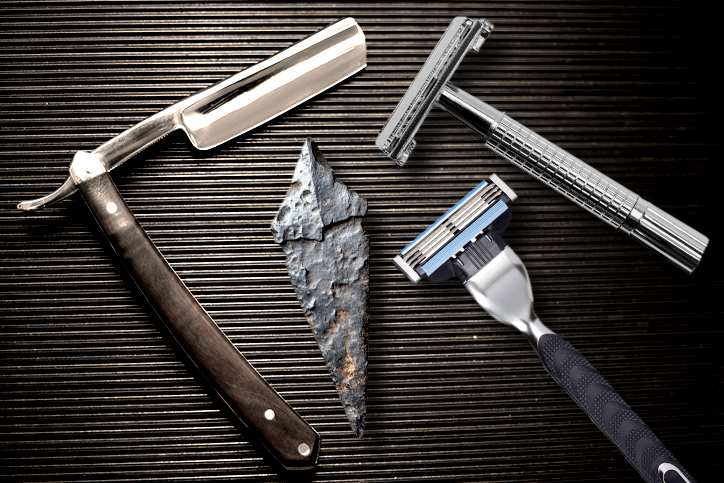
Shaving, a practice that many people do daily, has a rich history that spans thousands of years. From primitive tools to the multi-blade razors we use today, the evolution of shaving reflects not just advancements in technology, but also shifts in cultural norms, societal expectations, and personal grooming practices. The story of shaving is one of innovation, tradition, and even identity. Let’s take a look at how the act of shaving evolved from the Stone Age to the modern day.
The history of shaving dates back to prehistoric times. Early humans, like those in the Paleolithic era, used sharp objects like flint, seashells, and obsidian to remove body hair. Archaeological evidence suggests that these early razors were rudimentary, designed more for scraping than precision grooming. Shaving was not necessarily a daily routine but more of a survival tactic or cultural practice. Some ancient civilizations, including the Egyptians, took personal grooming seriously, and shaving became an important part of their daily rituals.
The Egyptians, in particular, are often credited with pioneering the use of razors. Evidence shows that they employed copper razors around 3000 BCE. Shaving in ancient Egypt was symbolic of cleanliness and social status, with both men and women regularly removing facial and body hair. The Pharaohs, for example, often depicted themselves as clean-shaven in statues, further emphasizing the importance of grooming.
Shaving became an integral part of Roman and Greek society. In ancient Rome, clean-shaven faces were considered a mark of civilization and personal hygiene. Roman men, especially those in the elite classes, would hire barbers to carefully groom them. Barbers became such a significant part of Roman society that they eventually formed a professional guild. The razor during this time was often made from bronze or iron and featured a straight edge. These straight razors were far more advanced than the tools of earlier civilizations, allowing for more precise and efficient grooming.
The Greeks, too, valued smooth skin, particularly among young men. They believed that a clean-shaven look was a sign of youth and beauty, while facial hair became associated with older, more rugged men. As a result, it was not uncommon for men to regularly shave as part of their grooming routine.
As Europe entered the Middle Ages, facial hair made a comeback. The beard became a symbol of masculinity, wisdom, and maturity. During this time, barbers continued to offer their services, but they often focused on trimming and shaping beards rather than shaving faces completely. Shaving tools evolved, with the straight razor becoming more refined and widely used.
However, it wasn’t until the Renaissance period that the clean-shaven look returned to popularity. Influential figures like King Louis XIII of France, who was famously clean-shaven, helped shape European fashion, leading to the resurgence of the smooth-faced ideal.
The 19th century saw a significant leap forward in shaving technology. With the Industrial Revolution came advancements in manufacturing and a growing demand for convenience. In 1847, William Henson patented the first version of the safety razor, designed to reduce the risk of cuts and nicks that often occurred with straight razors. This was a turning point in the history of shaving, as it made the process safer and more accessible to the general public.
In 1901, King Camp Gillette revolutionized shaving once again by introducing the disposable razor blade. Gillette’s innovation led to the creation of the modern safety razor, which quickly gained popularity due to its affordability and ease of use. The disposable blade became a staple of the grooming industry and remained a dominant product for much of the 20th century.
In the 1960s and 1970s, shaving technology saw further refinement. The introduction of the first electric razors provided a faster and more convenient option for many men. However, it was the 1990s and 2000s that saw a true revolution in razor design with the arrival of multi-blade razors. Companies like Gillette and Schick introduced razors with three, four, and even five blades, promising a smoother shave with fewer passes and reduced irritation.
The introduction of gel strips and pivoting heads further improved the shave, and the marketing of these products often emphasized the importance of comfort and precision. Today, razors have become highly specialized, with options for sensitive skin, ergonomic handles, and even heated blades. For some, shaving has become a luxury experience, a far cry from the primitive scraping of flint and shells.
From flint tools to five-blade razors, the history of shaving is a fascinating journey through human innovation and changing cultural norms. What began as a practical necessity has evolved into an art form, a self-care ritual, and an essential part of grooming. Today, shaving continues to serve both practical and symbolic purposes, from hygiene to personal expression. Whether it’s the simplicity of a straight razor or the advanced technology of a multi-blade system, the evolution of shaving reflects the constant drive for improvement, comfort, and style
No matter your blade preference, shop Bump Stopper products for healthier skincare.